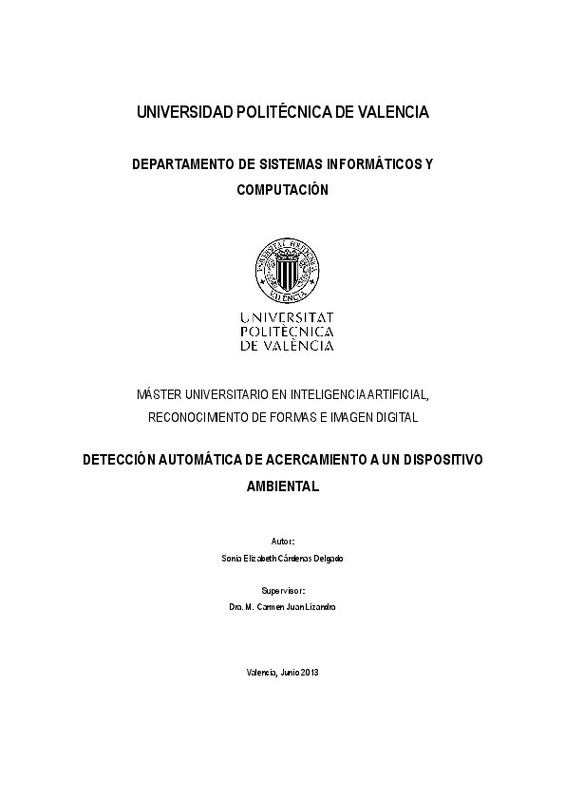JavaScript is disabled for your browser. Some features of this site may not work without it.
Buscar en RiuNet
Listar
Mi cuenta
Estadísticas
Ayuda RiuNet
Admin. UPV
Deteccion automatica de acercamiento a un dispositivo ambiental
Mostrar el registro sencillo del ítem
Ficheros en el ítem
| dc.contributor.advisor | Juan Lizandra, María Carmen
|
es_ES |
| dc.contributor.author | Cárdenas Delgado, Sonia Elizabeth
|
es_ES |
| dc.date.accessioned | 2014-11-20T08:13:20Z | |
| dc.date.available | 2014-11-20T08:13:20Z | |
| dc.date.created | 2013-07-10 | |
| dc.date.issued | 2014-11-20T08:13:20Z | |
| dc.identifier.uri | http://hdl.handle.net/10251/44468 | |
| dc.description.abstract | [EN] The increasing evolution of digital technology has allowed new computational approaches, and the development and use of different types of devices. For this reason, many researchers around the world have been devoted to this topic, seeking new forms of human-computer interaction. The opportunities for the development of technologies and natural interface tools are currently multiplying, the same as the manufacturing of environmental devices. In this dissertation, we have started research in the line of digital imaging and human-computer interaction. We have developed applications for automatic detection of approaching to a device. In the first application, we have used a type environmental device, Karotz, integrating an algorithm for image processing. In the second application, we used the Karotz and Kinect devices in an attempt to integrate their operation to obtain accurate and fast detection. In the third application, the integration is achieved and they work simultaneously, obtaining real time responses and novel user interaction through audio and visual cues of Karotz. The applications have been tested with a group of children. The results are quite encouraging, the precision obtained with applications 2 and 3 is similar, the response time varies between Kinect and Karotz connection. Both applications provide real-time results, while application 1, although provides the results off-line, it shows an acceptable range of accuracy and optimal execution time. Finally, we note that this is the first work for automatic detection of approaching with Karotz device. We pretend to continue with this research and the development of other applications. This would offer more services to facilitate their use for all types of users, and people with different disabilities, and especially the possibility of integrating automatic detection approaching in the auditory system. | es_ES |
| dc.description.abstract | [ES] La creciente evolución de la tecnología digital ha permitido nuevos enfoques computacionales, el desarrollo y uso de diferentes tipos de dispositivos. Por esta razón, muchos investigadores de todo el mundo se han dedicado a este tema, buscando nuevas formas de interacción humano-computadora. Las oportunidades para el desarrollo de tecnologías y herramientas de interfaz natural se multiplican al igual que la fabricación de dispositivos ambientales. En esta tesina se ha iniciado la investigación en la línea de imágenes digitales y la interacción hombre-máquina y se han desarrollado aplicaciones para realizar la detección automática de acercamiento a un dispositivo. En la primera aplicación se ha usado un dispositivo ambiental tipo Karotz integrando un algoritmo para procesamiento de imágenes. En la segunda aplicación se han utilizado los dispositivos Karotz y Kinect en un intento por integrar su funcionamiento para obtener precisión y rapidez en la detección. En la tercera aplicación se logra la integración y el trabajo simultaneo de ambos dispositivos, obteniendo respuestas en tiempo real y una interacción novedosa para el usuario a través de las funciones sonoras y visuales de Karotz. Las aplicaciones han sido probadas con un grupo de niños y niñas. Los resultados obtenidos son bastante alentadores dentro del estudio, la precisión obtenida con las aplicaciones 2 y 3 es similar, varía el tiempo de respuesta entre la conexión de Kinect y Karotz, ambas aplicaciones dan resultados en tiempo real, mientras que la aplicación 1, aunque ofrece los resultados en off-line, muestra un margen aceptable de precisión y un tiempo óptimo de ejecución. Finalmente, queremos señalar que al ser el primer trabajo que se hace sobre detección automática de acercamiento con el dispositivo Karotz, se pretende continuar con la investigación y desarrollo de otras características de los dispositivos ambientales. Con ello se ofrecerían más servicios que faciliten su uso a todo tipo de usuarios y a personas con distintos tipos de discapacidades y sobre todo la posibilidad de integrar la detección de acercamiento automática con el sistema de estímulos auditivos. | es_ES |
| dc.format.extent | 76 | es_ES |
| dc.language | Español | es_ES |
| dc.publisher | Universitat Politècnica de València | es_ES |
| dc.rights | Reserva de todos los derechos | es_ES |
| dc.subject | Deteccion automatica | es_ES |
| dc.subject | Acercamiento | es_ES |
| dc.subject | Dispositivo ambiental | es_ES |
| dc.subject | Automatic detection | es_ES |
| dc.subject | Approach | es_ES |
| dc.subject | Environmental device | es_ES |
| dc.subject.classification | LENGUAJES Y SISTEMAS INFORMATICOS | es_ES |
| dc.subject.other | Máster Universitario en Inteligencia Artificial, Reconocimiento de Formas e Imagen Digital-Màster Universitari en Intel·Ligència Artificial: Reconeixement de Formes i Imatge Digital | es_ES |
| dc.title | Deteccion automatica de acercamiento a un dispositivo ambiental | es_ES |
| dc.type | Tesis de máster | es_ES |
| dc.rights.accessRights | Abierto | es_ES |
| dc.contributor.affiliation | Universitat Politècnica de València. Servicio de Alumnado - Servei d'Alumnat | es_ES |
| dc.description.bibliographicCitation | Cárdenas Delgado, SE. (2013). Deteccion automatica de acercamiento a un dispositivo ambiental. http://hdl.handle.net/10251/44468 | es_ES |
| dc.description.accrualMethod | Archivo delegado | es_ES |






